Unlock the Secrets of Towing: How Weight Distribution Systems Work
June 12, 2023
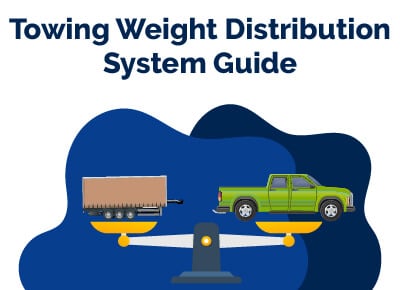

Michael Collado is a car buying expert and has been a professional automotive writer since 2009. He’s written about dealership sales, vehicle reviews and comparisons, and service and maintenance for over 100 national automotive dealerships. Previously, Collado was a copywriter at the ad agency TBWA/Chiat/Day where he worked on brand campaigns for Nissan, ABC Television, Sony PlayStation, and Energizer. His recognition in the ad industry includes awards from Communication Arts and The Clios.
Collado has a Bachelor’s degree from the University of South Florida, with a major in Psychology and a minor in Marketing.
Towing a trailer can be tricky, especially when it comes to distributing the weight of your load.
Weight distribution systems are an important tool for ensuring that your trailer is properly loaded and balanced so you can enjoy safe travels on the road.
But how do these systems work?
Table of Contents
What is a Weight Distribution System?
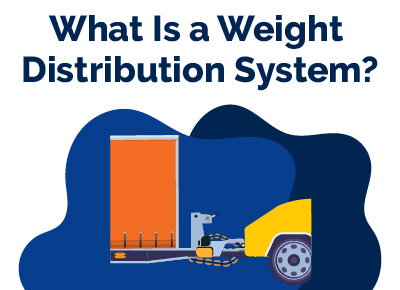
A weight distribution system is a type of hitch used to evenly distribute the load on a vehicle and trailer.
It works by transferring some of the tongue weight from the back of the tow vehicle to its axles, as well as distributing it more evenly between all four wheels. This helps improve handling and braking performance, reduce swaying, and minimize wear and tear on tires, brakes, suspension components, ball mounts, couplers, hitches, and other parts.
There are several types of weight distribution systems available for different types of vehicles.
- A trunnion-style system uses two bars that attach at each end with adjustable brackets; this allows for quick installation without having to make any adjustments.
- A round bar system has one long bar that attaches in the middle with adjustable brackets; this gives you more control over how much weight is distributed across each axle but requires more time for setup.
- Finally, there's a dual cam style which has two independent cams that can be adjusted separately; this provides maximum flexibility when setting up your system but also takes longer than other options.
The advantages of using a weight distribution system are manifold:
- improved safety and stability when cornering or braking
- extended tire life
- reduced wear on suspension components
- increased fuel efficiency
- less strain on the ball mount
Don't forget regular maintenance checks. Inspect all connections regularly for signs of rust or corrosion build-up, especially if you live in wet climates. Check spring bars and chains for signs of wear and tear, replacing them if necessary. Replace worn-out parts immediately; these simple steps will ensure optimal performance and safety from your WDS.
Key Takeaway: Ensure your WDS is securely fastened with clamps or U-bolts and routinely inspect all parts for any evidence of rusting or corrosion to guarantee optimal performance and security. Regular maintenance will ensure your WDS performs at its best over time.
How Does a Weight Distribution System Work?
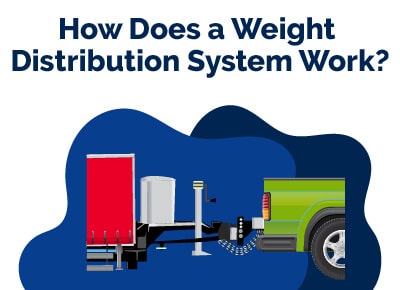
The hitch head and shank are two components that make up the main structure of a weight distribution system. The hitch head attaches to the frame of your vehicle, while the shank fits into it and allows for the attachment of other components like spring bars or chains. This combination creates a secure connection between the tow vehicle and trailer, helping keep them in line with each other during travel.
Spring bars and chains are then used to transfer some of the tongue weight from the trailer onto both axles on either side of your vehicle’s frame – thus distributing its load more evenly across all four tires. The spring bars also provide additional stability by absorbing shock when traveling over bumps or uneven terrain. Chains attach to either end of these springs, creating tension between them so they don't become too loose during use.
Key Takeaway: Weight distribution systems are essential for ensuring your vehicle's load is evenly distributed and preventing swaying. These systems consist of a hitch head, shank, spring bars and chains which all work together to transfer the tongue weight from the trailer onto both axles on either side of the frame - creating an effective 'load balancing act'.
Setting Up the Weight Distribution System
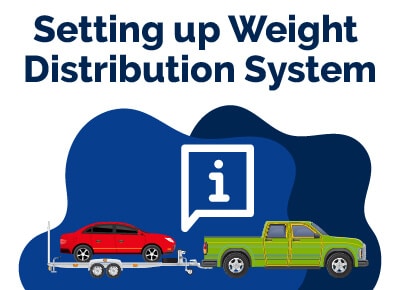
To ensure proper weight distribution, the spring bars must be adjusted accordingly by measuring the amount of load on each wheel. The spring bars are connected to the hitch head and shank, and they are responsible for distributing the load evenly across all four wheels of your vehicle.
To adjust them correctly, you must first measure how much weight is on each wheel. Once you have that information, use a torque wrench to set the tension of each bar according to the manufacturer's specifications. Ensuring that all four springs are adjusted together is critical for having a balanced weight distribution across the wheels.
After adjusting the spring bars, you will need to attach sway control brackets to your trailer or caravan frame before connecting them with chains or cables to your vehicle’s towbar assembly. This step helps keep your trailer or caravan stable while driving by reducing sway caused by wind gusts and other external forces acting upon it from behind.
To do this properly, start by attaching one bracket at a time using bolts provided with your kit – make sure these bolts are tightened securely before moving on to attaching any additional brackets as needed for extra stability.
Finally, connect each bracket with its corresponding chain or cable and secure everything firmly in place with clips provided in most kits; this ensures that no movement occurs between components during transit which can cause damage over time if not addressed promptly.
Once the spring bars are adjusted and the sway control brackets are attached, your weight distribution system is ready to use. To ensure that it continues to perform properly, regular maintenance of your weight distribution system is essential.
Key Takeaway: To set up a weight distribution system correctly, it's important to adjust the spring bars with a torque wrench and attach sway control brackets onto the trailer or caravan frame. After that, secure everything in place by connecting each bracket with its corresponding chain or cable before hitting the road.
Maintaining Your Weight Distribution System
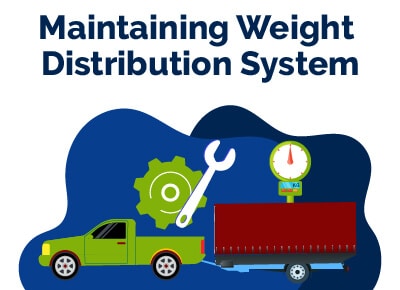
Inspecting the hitch head and shank should be done regularly, especially after long drives or off-roading trips.
Make sure that all bolts are securely fastened, there is no rust or corrosion present, and that everything looks intact. If any signs of wear or damage are observed, it is essential to replace them straight away with new components. Also, make sure that the ball mount fits snugly into the receiver tube so it doesn’t move around while driving.
Checking the spring bars for wear and tear should also be done periodically.
Look for cracks or bends in the metal, which can weaken their strength over time; if you find any damaged areas then they need to be replaced right away before further use. Additionally, inspect all connecting hardware, such as pins, clips, nuts & bolts; these items can become loose from vibration during travel, so make sure they’re properly tightened down before continuing on your journey.
Finally, when it comes time to replace worn parts, always use genuine OEM replacement components specifically designed for your vehicle's weight distribution system.
Generic aftermarket components may not fit correctly or provide adequate support, resulting in a poor ride quality experience - something nobody wants. Therefore take care when selecting replacements and ensure they are installed properly according to manufacturer instructions prior to using them again on future trips out onto roads less traveled.
Key Takeaway: It is essential to regularly inspect and maintain your weight distribution system, replacing worn parts with genuine OEM components as needed. To ensure safety and performance, check the hitch headshank for rust or corrosion, look over spring bars for cracksbends in metal, and make sure all connecting hardware such as pins are securely fastened.
Troubleshooting Common Issues with Weight Distribution Systems
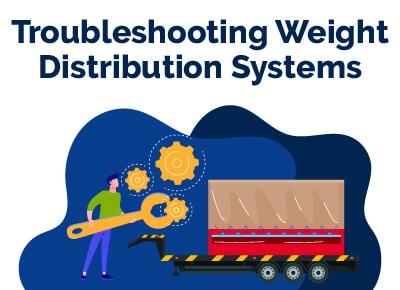
Loose connections or rattling noises from the hitch head or shank area may indicate an improperly attached ball mount or coupler assembly. Inspect each component thoroughly and tighten any loose bolts if necessary.
If there are still issues after tightening them up, consider replacing worn parts as needed in order to restore the proper operation of your system.
Excessive swaying during driving conditions is often caused by incorrect installation of either the spring bars or chains used in tandem with a sway control bracket setup. It is important to ensure that both components are correctly connected and adjusted so they work together efficiently without putting too much strain on one side over another.
Additionally, it is essential to inspect both pieces regularly for wear-and-tear damage, which could cause further instability when driving down highways at higher speeds.
Best Car Deals by Category
Frequently Asked Questions
How does a weight distribution tow hitch work?
It uses spring bars and brackets that attach to both the trailer and vehicle, allowing for an even transfer of weight from one side to another. This helps reduce swaying when traveling at high speeds or on uneven terrain, as well as reducing stress on suspension components in both vehicles. Weight distribution hitches also provide better stability while turning or braking sharply, making them essential for safely hauling heavy loads.
Does a weight distribution system increase towing capacity?
Yes, a weight distribution system can increase towing capacity. Weight distribution systems help balance the load of a trailer or other towed vehicle across all axles of the tow vehicle, allowing it to safely and effectively pull heavier loads.
How does a weight distribution and anti-sway hitch work?
It also helps reduce any swaying motion by transferring some of the tongue weight from the back axle onto all axles, providing greater stability when driving.
Do you really need a weight distribution hitch?
The capacity for towing a trailer or camper varies depending on the type of automobile. For heavier loads, a weight distribution hitch is necessary to ensure even load distribution across all axles and improved stability when driving.
Posted in Car Buying Tips |




